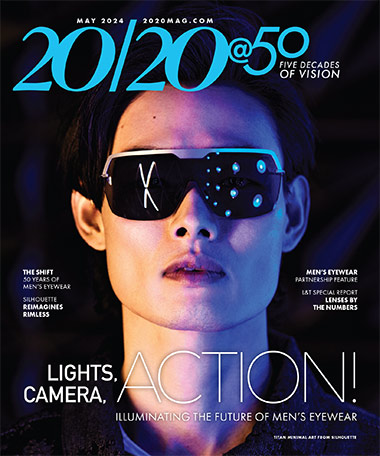
|
Recently, I was relaxing on Lanai with some of my colleagues at the Optician's Club, watching the yachts float by in the sound, when the topic of online optical arose. As is oft the case when this particular subject matter is discussed, the conversation inevitably turned towards that particular specter that haunts the halls of the optical world: Warby Parker.
"Terrible outfit," said Phineas, sipping his Tom Collins. "Awful product."
"Indeed," said Hazel, adjusting his sunglasses—first by realigning a nosepad and then straightening them on his face. "Who in their right mind would pay for that garbage is beyond me!"
Having never before handled a pair of Warby Parker frames, I was intrigued as to what was so bad about them.
"What's so bad about them?" I asked.
"They're hideous," Hazel drawled.
"Chinese made tripe," Phineas said.
I pondered this for a moment. "Most of the frames we sell are Chinese made, though," I said. "And the look of the frames is especially popular with the teen to thirty-something demographic."
There was no argument here, and we all paused a moment to drink and toast ourselves for our general awesomeness. The conversation then returned to Warby Parker.
"So what's bad about the quality of the frames themselves?" I asked.
The only sound was the breakage of the water as an optician jet skied by. Then, Hazel whispered: "Well… I've never actually handled a pair before."
"Nor have I," Phineas added with gravity.
"Then none of us have ever actually assessed the product being sold by one of our chief competitors!" I exclaimed.
There was a moment of general panic broken when an idea occurred to me and I suddenly stood erect, nearly toppling a butler in the process. "By Jupiter's beard! I'll get my hands on a few pairs and check them out myself!"
...MOSTLY
Although there's a (large) deal of hyperbole involved in the above paragraph, there is more than a grain of truth to it. The topic of online optical in general, and Warby Parker in particular, often comes up during discussions with my colleagues. A recent chat included the revelation that, despite our combined multiple decades of experience, none of us had ever bothered to actually assess the product being generated by the company we all consider to be a major competitor with, and potential threat to, the world of brick and mortar optical. Being the most eager (and impulsive) of the bunch, I decided to obtain several pairs of the company's frames and give them an honest assessment, not as a competitor, but as a lover of eyewear.
 |
| Frames: Warby Parker Marlowe |
My first thought upon laying eyes on the frames was that they were, aesthetically speaking, quite beautiful. The frames all have a high polished luster and are offered in a variety of striking colors. The designs of the frames themselves are both innovative and classic, drawing on vintage styling while also innovating new looks. In a field that, until recently, had stagnated on the design side of things, it's refreshing to see a manufacturer actually breaking the mold instead of churning out the exact same design in brown or gunmetal, black or tortoise. Although 99 percent of the company's frames do fall firmly into hipster/retro territory, one of the frames I obtained—The Marlowe—was a more traditional metal, rectangular frame that, while still "outside the box" design wise, would probably appeal to an older consumer looking for something new without being too new.
CONSTRUCTION
This was the real test, as far as I was concerned. I'd heard the rumors, the gossip, the hyperbole. It was time to answer the question once and for all: Are Warby Parker frames cheap pieces of junk?
First let me say that the quality of Warby Parker's frames is, far and away, beyond what you'll find in the optical shop of any of the big box retailers: the kind whose bridges will melt and twist apart when you try to clean the lenses after leaving the frames on the counter during a hot shower. (Been there, done that). In the pecking order of frame quality, Warby Parkers are most certainly not at the bottom of the echelon, nor are they anywhere near it.
That being said.
The frames suffer from what I call "hollow zyl syndrome." Someone out there probably has a more technical name for it, and I'd be glad to hear it. You probably know what I'm talking about, though. The zyl that gives you a hollow "click click" sound when you tap it with your fingernail. The zyl that seems more rigid than it ought to, sharing more in common with wood than rubber in the way of consistency.
That zyl.
Perhaps this is a bit of the optician slipping in, but I prefer more pliability to my zyl. Something that bends easier will break harder, and is generally easier to reshape, adjust, and make comfortable to the wearer. From the customer standpoint, this will probably not be an issue; the construction of the frames, generally sturdier than many of the zyls that the average consumer is used to purchasing, will probably be enough to win over most individuals.
The hinges are another story: They're perhaps some of the nicest, most well made hinges I've seen on frames of late. For the most part, the company' s shied away from what would undoubtly be the more popular spring hinge in favor of some classic standard hinge styling that's both tight enough to keep the frames firmly situated but also loose enough for comfortable wear. The aforementioned Marlowe frame was also a surprising piece of engineering, with nosepads that were easily adjusted and a frame density and durability rivaling that commonly found in many "name brand" frames of comparable design and quality.
VARIETY
Materials aside, there is one design aspect of the frames severely lacking: Sizing.
Just like most other frame manufacturers, WP jumped on the bandwagon of 1) Severely misjudging the size of the average American's head, and 2) Only offering select, often boring styles "outside of the box." Individuals with smaller, narrower heads will find themselves with a plethora of choices. Anyone else will be left out of the party. This is evident from the selection of frames I chose: While the circumference of my head is quite large, I'm strangely narrow through the temple region, and most small and medium sized frames fit me quite well. Of the variety of WP frames I tried out, all but one were head-squeezingly little, more suited to a teenager or generally small-headed man. Indeed, some of the unisex frames labeled as "medium" were better suited to the head of my 5'2 wife than my own. Those desperate for a WP frame who must go to the "Wide" category will find themselves with only nine frames to choose from, representing a narrow margin of the styles, designs, and colors available in their tinier counterparts.
BACK AT THE OPTICIAN'S CLUB…
So what's the final word on Warby Parker frames?
I make no judgments here about the morality or ethics of online optical; the fact remains, though, that it is a reality, and as something that touches the optical world, it is something that needs to be given an honest assessment. My final, honest assessment of Warby Parker is as such: While they are not on par with the frames currently being produced by some of the higher-end labels, they are far superior to those being sold at many brick and mortar opticals right now. They are most certainly not junk; and if their current state is indicative of a company in the throes of expansion and improvement, their quality can be expected to rise. Regardless of one's feelings about the world of online optical, this does indeed make Warby Parker a force to be reckoned with, and, more importantly, observed carefully.












